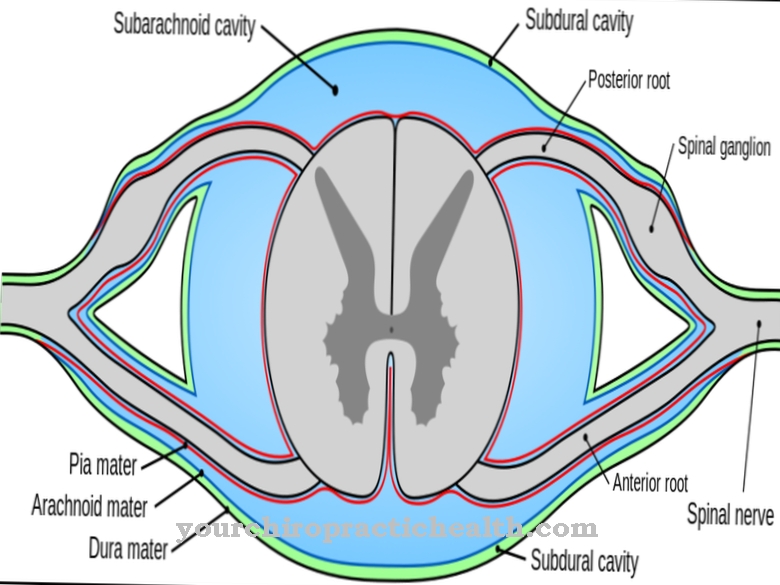At Epithilies it is cells from the glandular and connective tissue. The name is a collective term that is also known as "surface covering cell layer". The tissue has important functions that can be influenced by different diseases.
What are epithilies?
Epithilium can consist of one or more layers of cells. There are different cell types that differ based on different characteristics. For example, multi-layer epithelial cells can be found in the esophagus and vagina, while single-layer epithiliums are localized in the gastric and intestinal mucosa.
Multi-row epithelial cells are located in the airways, transitional epithelium in different elements of the urinary system. All body surfaces are surrounded by epithilium on the inner and outer side in humans. Only the joint capsules and the bursa are excluded from this rule. In addition to muscle, nerve and connective tissue, the cells represent another type of tissue. Normally, only a small proportion of blood vessels are found in the epithelial tissue. It is important in the overall health of the skin.
Anatomy & structure
The epithelial cells are separated from the connective tissue by a basement membrane, which consists of certain proteins. Epithelial cells lying next to one another, however, are continuously in contact with one another. If you look at a single cell, you will notice that it contains only a very small amount of intercellular substance. Epithelial cells are polarized, they can partially differentiate directions from each other.
The decisive factor for this property is their location: either epithelial cells are located between the body and air or within the organism between connective tissue and the lumen. In principle, they are responsible for always separating two areas from one another. The outer side is called apical. It tends towards the outer part, such as the skin or the lumen. The basal side, on the other hand, is in contact with the tissue, which is located below the epithelial tissue. The connection is made via another membrane.
Function & tasks
The functions and tasks of epithelial cells are very different and depend on various factors. Epithelial cells within the glandular tissue have different work steps than cells that are located in surfaces. In addition, the surrounding organ also determines the tasks of the tissue. Nevertheless, the range of tasks can be divided into protective, sensory, secretion and transport functions. The protective function is particularly evident on the surface of the skin: so that there are no injuries and cracks, the skin must be elastic and firm.
In addition, the epithelial cells ensure that the connective tissue does not detach itself from the skin, but is firmly anchored in it. At the same time, organs are sealed by the epithelial cells. This is the only way to ensure that the stomach contents remain in the stomach and the leftover food in the intestine. But the tissue is also responsible for protecting against mechanical stimuli with regard to internal organs. In the context of the sensory function, it is noticeable that the majority of cells in sensory organs can be localized within epithelial tissue. Here the epithelial cells are useful in that they can connect internal and external elements.
Accordingly, epithelial cells help to see, smell and taste. They are located in the human retina, on the back of the tongue and in the olfactory mucosa. In addition, they transmit mechanical stimuli such as temperature and pain sensations to the brain. The epithelial cells can also remove foreign bodies using very fine hairs, so-called cilia. The body's own secretion in the form of sweat or other substances takes place via glandular epithelial cells. In addition to secretions such as tears, hormones are also released here, such as thyroid hormones. Epithelial cells thus take on numerous and important tasks.If their function is restricted, different symptoms and complaints can occur. It is therefore advisable to go to the doctor quickly.
Diseases
Different viruses and bacteria have the potential to penetrate the epithelial tissue and damage it. In the case of viral diseases, this is often an infection with the herpes virus. Herpes viruses can cause cells to swell and fluid to accumulate. A high level of leukocytes can often be detected in this. Bacterial infections often occur via streptococci and staphylococci.
The penetration and reproduction of bacteria can cause inflammation. This is how wound roses develop, for example. The bacteria get into the epithelial tissue in different ways and cause swelling and pain due to extensive inflammation. Depending on the time of diagnosis is also the following treatment. Even if this has been successfully completed, a recurrence of the disease cannot be completely ruled out. Apart from pathogens, tumors can also affect the epithelial layer. These are benign or malignant changes in the tissue. Both carcinomas and basal cell carcinomas can develop.
While basaliomas do not metastasize, they still have the potential to spread to the surrounding tissue and cause further damage there. The epithelium surrounds different organs. If there are diseases of the vessels that are supplied by the epithelial cells, vascular-related epithelial diseases can appear. For example, capillary loops in the skin can damage the basement membrane and be responsible for blood penetrating the epithelial tissue. Autoimmune diseases can also cause the epithelial layers to loosen. This can lead to allergies, itching, hives, or swelling. Immunological reactions may be responsible for the separation between the epithelium and the underlying tissue.
You can find your medication here
➔ Medicines against redness and eczemaTypical & common skin diseases
- Vitiligo (white spot disease)
- skin rash
- Skin fungus
- Rosacea (rosacea)
- Systemic lupus erythematosus (SLE)
- Skin cancer
























.jpg)



